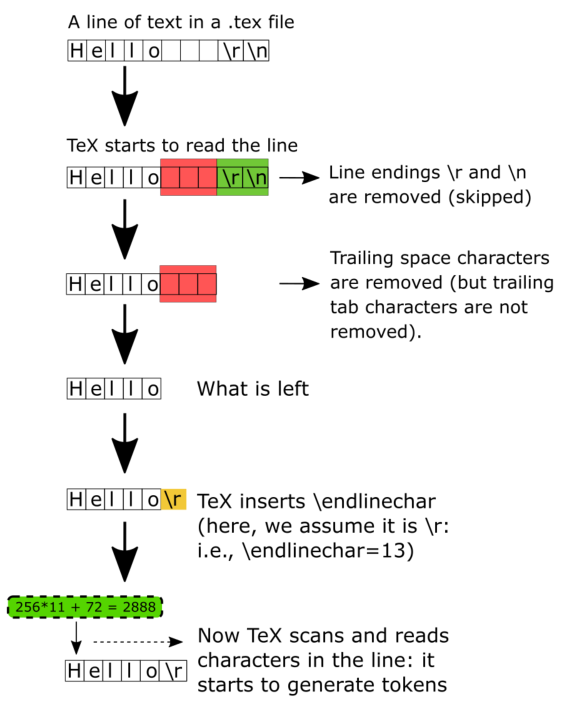Coding in TeX
Preface
Example
你也许在部分的模板或者是宏包中看到过类似下面的东西, 那么这些东西是啥意思呢 ?
1 | |
如果你熟悉 ASCII 码表的话,你会发现这两个东西和 脱出字符表示 比较相似. 比如 回车(CR) 的脱出字符表示为: ^M . 而 换行(LF) 的表示为 ^J . 我们在后文会介绍的这个东西的,但是在介绍之前,你需要先了解部分的基础知识,关于字符和编码的基础知识.
字符与编码
进制
在 TEX 的内部使用 '(单引号)后加数字表示八进制,"(双引号)后接数字表示十六进制。下面便有几个示例。注:我们使用原语 (primitive) 的\number命令进行十进制输出:
- 八进制:
\number'10结果:8 - 十进制:
\number10结果:10 - 十六进制:
\number"10结果:16
基本规则
TEX 内部的字符是有各自的编码的,下面先演示一句话:
神秘代码:
1 | |
具体的规则如下:
-
连续两个上标符号
^^后跟一个字符c,可以表示另一个字符c':- 64 ≤ ASCIIc ≤ 127 ⇒ ASCIIc’ = ASCIIc - 64
- 0 ≤ ASCIIc ≤ 63 ⇒ ASCIIc’ = ASCIIc - 64
-
^^后跟两个小写十六进制数字,可以表示任意 ASCII 符号:1
2
3^^68^^65^^6c^^6c^^6f^^2c^^20^^77^^6f^^72^^6c^^64^^21
% 输出结果为: hello, world!
转换
我们可以使用原语 \number 轻松的输出字符对应的 ASCII 数值(ASCII 中的字符和十进制之间的相互转换), 同时也可以使用 [`] 输出一个字符对应的编码. 也就是:
- 字符 ⇒ 编码:`<字符>
- 编码 ⇒ 字符:\char<编码>
编码转换使用的是前引号: [`], 但是 8 进制使用的是后单引号: [
']
下面展示关于字符到编码的几个使用样例:
1 | |
但是如果我们输入了
1 | |
即一个非 ASCII 字符, 那么为什么会得到这个东西呢?其实此时它会按照 Unicode 字符集进行映射. 下面再展示几个编码到字符的转换样例:
1 | |
我们可以使用 \char 命令进行一些不方便使用输入法键入的繁体字的录入,前提是我们得知道它的 Unicode 编码。所以必要时你需要指定一个支持中文,且支持中文数量比较的字体,例如可以使用如下的设置:
1 | |
Pre-defined coding
catcode
basic
The basic catcode table as follows:
| 类别码 | 含义 | 符号 | ASCII 码(HEX) |
|---|---|---|---|
| 0 | 转义符 | \ | 5C |
| 1 | 组开始 | { | 7B |
| 2 | 组结束 | } | 7D |
| 3 | 切换数学环境 | $ | 24 |
| 4 | 表格对齐 | & | 26 |
| 5 | 回车 | CR | 0D |
| 6 | 参数 | # | 23 |
| 7 | 上标 | ^ | 5E |
| 8 | 下标 | _ | 5F |
| 9 | 可忽略字符 | NUL | 00 |
| 10 | 空格 | SP | 20 |
| 11 | 字母 | A~Z, a~z | - |
| 12 | 其他字符 | 本表未列出的其他符号 | - |
| 13 | 活动字符 | ~ | 7E |
| 14 | 注释 | % | 25 |
| 15 | 无效符 | DEL | 7F |
end line char
其实现在我们已经把 回车(CR/\r) 和 换行(LF/\n) 两个概念给混淆了, 前者一般的 ASCII 码为 13, 后者为 10. 可以简单的认为 “回车” 就是把光标移动到当前行的行首(水平移动), 而 “换行” 就是把光标移动到下一行的同一水平位置(垂直移动).
现代意义下的 “换行” 和 “回车”基本已经表示同一个东西了, 也就是 CRLF. 并且不同的操作系统上的这个现代意义上的“换行”的表示方法还不一样: Unix-base 的操作系统用的是 LF, 一些比较老的 MacOS 用的是 CR, 而大部分人用的 Windows 其实是 CRLF.
TeX 是一个跨平台的应用, 这是大家都知道的。所以为了处理这个烦人的“换行”问题, TeX 引入了一个叫做: \endlinechar 的东西. 这个 \endlinechar 和 catcode 有啥关系呢 ? 其实就是下面这两句话:
\endlinechar对应的字符一般是 ASCII 13 这个字符, 也就是\r. 合法的 ASCII code 取值范围是: (-1, 256), 不取两个边界值 .- 同时 ASCII 13 这个字符 (
\r) 对应的 catcode 一般是5.
TeX 处理你的 tex 文档的基本逻辑是这样的, 以下的讨论均基于默认情况下, 所注释的 ASCII 码和其它的数字均为 10 进制:
- 逐行从你的 .tex 文件中读入 tokens, 并不是把整个文件同时塞到内存里面的.
- 把每一行的换行符(
\r, 或者是\n) 及其末尾多余的空格(ASCII code 32)去掉, 但是并不会把 ASCII 码为 9 对应的 Tab 给移除掉. - 然后再把合法的
\endlinechar添加到行末 - 然后就开始扫描这一行中的具体内容了, 扫描每一个 token
- 然后根据这个
\endlinechar的 catcode 决定接下来该做什么,应为有时候面对复杂的任务,这个\endlinechar对应的 catcode 也许是\active的. - 那么具体是做什么呢 ? 也许是把这个
\endlinechar变为 一个空格,也许是把两个连续的\endlinechar变为\par这个 token. (TeX 使用 catcode 为 5 的 character 去做这件事情)
如果你觉得上述的文字描述不够直观,可以看看 Overleaf 上原博客中提供的这幅图:

所以,如果你想要避免换行,那么你可以把 \endlinechar 定义为一个非法字符或者是其它的字符. 下面就是一个示例:
1 | |
对应的输出的 pdf 如下:

可以看到,中间的那两个 :: token, 在默认情况下就会被转为 \par 这个 token. 但是此时 : 对应的 catcode 并不是 5, 所以它并没有变成 \par .
active character
对于 活动字符 可以做的事情就比较多了, 你可以直接把 活动字符 看作一个 cs, 然后对它进行定义, 参见下面这个结合了 catcode 和 mathcode 的例子:
1 | |
这段代码输出的结果为:
如果你对于 mathcode 不熟悉,那么可以参见我的另一篇文章: math code
initial
1 | |
others
When INITEX begins, category 12 (other) has been assigned to all 256 possible characters, except that the 52 letters A...Z and a...z are category 11 (letter), and a few other assignments equivalent to the following have been made:
1 | |
Thus \ is already an escape character, ␣ is a space, and % is available for comments on the first line of the file; ASCII ⟨null⟩ .
mathcode
The correcponding definitions as below:
1 | |
Or you can see the table:
| column 1 | column 2 | column 3 |
|---|---|---|
| \mathcode`^^@="2201 | \mathcode`^^A="3223 | \mathcode`^^B="010B |
| \mathcode`^^C="010C | \mathcode`^^D="225E | \mathcode`^^E="023A |
| \mathcode`^^F="3232 | \mathcode`^^G="0119 | \mathcode`^^H="0115 |
| \mathcode`^^I="010D | \mathcode`^^J="010E | \mathcode`^^K="3222 |
| \mathcode`^^L="2206 | \mathcode`^^M="2208 | \mathcode`^^N="0231 |
| \mathcode`^^O="0140 | \mathcode`^^P="321A | \mathcode`^^Q="321B |
| \mathcode`^^R="225C | \mathcode`^^S="225B | \mathcode`^^T="0238 |
| \mathcode`^^U="0239 | \mathcode`^^V="220A | \mathcode`^^W="3224 |
| \mathcode`^^X="3220 | \mathcode`^^Y="3221 | \mathcode`^^Z="8000 |
| \mathcode`^^[="2205 | \mathcode`^^="3214 | \mathcode`^^]="3215 |
| \mathcode`^^^="3211 | \mathcode`^^_="225F | \mathcode`^^?="1273 |
| \mathcode`\ ="8000 | \mathcode`!="5021 | \mathcode`\’="8000 |
| \mathcode`(="4028 | \mathcode`)="5029 | \mathcode`*="2203 |
| \mathcode`+="202B | \mathcode`,="613B | \mathcode`-="2200 |
| \mathcode`.="013A | \mathcode`/="013D | \mathcode`:="303A |
| \mathcode`;="603B | \mathcode`<="313C | \mathcode`=="303D |
| \mathcode`>="313E | \mathcode`?="503F | \mathcode`[="405B |
| \mathcode`\="026E | \mathcode`]="505D | \mathcode`_="8000 |
| \mathcode`{="4266 | \mathcode`|="026A | \mathcode`}="5267 |
delcode
The catcode of delimiters in formulas, Reference from “The TeXbook”:
The last code table is called
\delcode, and again it’s necessary to change only a few values. INITEX has made all delimiter codes equal to−1, which means that no characters are recognized as delimiters in formulas. But there’s an exception: The value \delcode`.=0 has been prespecified, so that.stands for anull delimiter. (See Chapter 17.)
Plain format sets up the following nine values, based on the delimiters available in Computer Modern:
1 | |
play with code
Here is something you can play with:
-
[ ] Write environment verbatim to file
-
[ ] add
REFERENCE
Reference as below:
- xetexref
- source2e
- TeXbyTopic
- runoob ascii table
- TeXbook – Appendix B: BasicControlSequences
- Difference between CR LF, LF and CR line break types
- An introduction to \endlinechar: How TeX reads lines from text files
